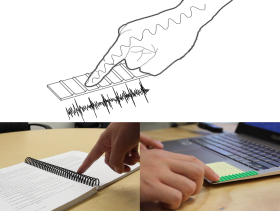« Back to Publications list
Exploring Design Factors for Transforming Passive Vibration Signals into Smartwear Interactions
Abstract
Vibrational signals that are generated when a finger is swept over an uneven surface can be reliably detected via low-cost sensors that are in proximity to the interaction surface. Such interactions provide an alternative to touchscreens by enabling always-available input. In this paper we demonstrate that Inertial Measurement Units (known as IMUs) embedded in many off-the-shelf smartwear are well suited for capturing vibrational signals generated by a user’s finger swipes, even when the IMU appears in a smartring or smartwatch. In comparison to acoustic based approaches for capturing vibrational signals, IMUs are sensitive to a vast number of factors, both, in terms of the surface and swipe properties, when the interaction is carried out. We contribute by examining the impact of these surface and swipe properties, including surface or bump height and density, surface stability, sensor location, swipe style, and swipe direction. Based on our results, we present a number of usage scenarios to demonstrate how this approach can be used to provide always-available input for digital interactions.
Video
Citation
Teng Han, David Ahlström, Xing-Dong Yang, Ahmad Byagowi, and Pourang Irani. 2016. Exploring Design Factors for Transforming Passive Vibration Signals into Smartwear Interactions. In Proceedings of the 9th Nordic Conference on Human-Computer Interaction (NordiCHI '16). ACM, New York, NY, USA, Article 35, 10 pages.

Authors

Teng Han
Alumni
Dr. David Ahlström
Associate Professor
Xing-Dong Yang
Alumni
Pourang Irani
ProfessorCanada Research Chair
at University of British Columbia Okanagan Campus
As well as: Ahmad Byagowi
